What Goat Breeds Are Best for Meat?
While it has yet to catch on in the United States on a commercial scale, goat meat is eaten regularly by over 60% of the global population. Goat meat is a healthy alternative to other sources of red meat and is comparatively eco-friendly. Meat goats are a wise investment in niche markets and self-sustaining homesteads.
What are the best goat breeds for meat? Successful meat goats will ideally have a fast growth rate, a prolific reproduction rate, and a high meat-to-bone ratio. Eight of the most productive meat goat breeds are:
- Boer Goat
- Kiko Goat
- Myotonic Goat (Fainting Goat)
- Nubian Goat
- Rangeland Goat
- Savanna Goat
- Texmaster Goat
- Pygmy Goat
Not all meat breeds were created equally, so read on to learn more about how each of these breeds could benefit your operation.
#1 Meat Goat Breed: Boer Goat
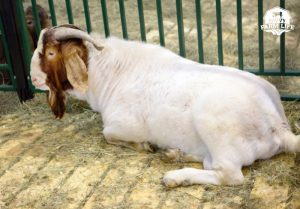
Boer goats are the #1 meat goat in the world. They are also the largest among goat breeds. Does (females) can mature over 200 pounds, while bucks (males) can top out at around 340 pounds! Boers are known to gain weight rapidly, a desirable trait among meat-producing goats, and can gain almost ½ a pound per day.
Boer goats breed prolifically, making them successful in self-sustaining operations. If you have the space and the inclination to facilitate breeding, it is often more economical to breed and raise your meat instead of purchasing young kids each season from another farm. Boers commonly give birth to two or more kids and can be bred twice in three years.
Because the Boer was developed in South Africa under harsh conditions and scarce feed, it has evolved into a goat that can gain significant weight under less-than-ideal feed rations. These conditions have also encouraged hardiness in the Boer, although there is some evidence that the breed is more susceptible to internal parasites when raised in hot, humid climates.
Because there used to be more demand for Boer breeding stock than supply, some Boer lines have been pampered over the years and have lost some of their vigor. For this reason, Boer herds, on the whole, will typically require more intensive management practices than other breeds.
#2 Meat Goat Breed: Kiko Goat
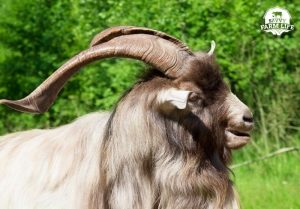
If you live in a wet climate but would like a goat similar in meat production to the Boer, the Kiko would be a great option. Kikos are slightly smaller than Boers, with females reaching as much as 180 pounds and bucks around 275 pounds at maturity. They grow rapidly, and in a study done by Tennessee State University in 2004, female Kikos produced more pounds of kid than female Boers when raised in like conditions.
Kikos originated from an indigenous goat species in New Zealand. They are distinguished from many other meat breeds in that they can achieve maximum meat output on pasture and forage alone, negating the need for (expensive) supplemental feed.
Kikos are less susceptible to internal parasites and foot rot than most other goat breeds and do well in almost any climate.
#3 Meat Goat Breed: Myotonic Goat (Fainting Goat)
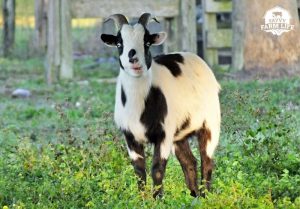
Myotonic, or Tennessee Fainting Goats, are the goats made famous because of a unique genetic trait that causes them to “faint” when startled. This cannot be considered fainting, as the goat does not lose consciousness. Instead, its muscles lock up when frightened or surprised and thus causes the animal to fall over and remain immobile for 10-15 seconds. The condition is harmless to the goat.
The gene that causes their muscles to lock upon being startled is the same that allows the Myotonic to develop exceptional muscle growth compared to other goat breeds. Myotonic goats are heavily muscled in both the rump and the chest, though smaller than the Boer and Kiko, with adults reaching 50-175 pounds at maturity. This muscle allows for more meat to bone ratio in the carcass – 4:1 instead of the 3:1 yielded by other meat breeds.
Myotonic goats are also easy to keep fenced in – they generally seem content to stay confined. This makes them an excellent option for smaller operations worried about keeping escape-artist goats from jumping less-than-ideal fences.
#4 Meat Goat Breed: Nubian Goat
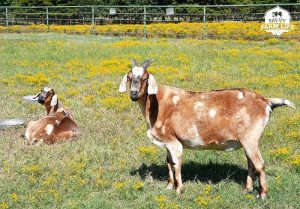
The Nubian goat breed is popular all over the world. While Nubians are great for meat, they also rank in one of the best goat breeds for milk production. So, if you’re looking for a dual-purpose goat breed, the Nubian may be a great choice!
Nubians have a more extended breeding season than most other goat breeds, increasing their breeding success rate. These goats can get quite large, ranging anywhere from 175 – 300 lbs, depending on the gender. They also tend to be used in breeding to improve bloodlines and qualities in other goats. Many small goat breeds are bred with Nubians to produce a smaller yet productive breed. You can learn more about these small productive breeds by visiting my article 8 Adorable Small Goat Breeds (With Pictures.)
#5 Meat Goat Breed: Rangeland Goat
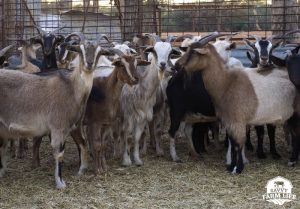
Originating from Australia, the Rangeland goat is another heat-tolerant breed, doing exceptionally well in hot, dry climates. The Rangeland is a large goat with a desirable carcass composition and accounts for 90% of Australian goat meat production. In addition, they are often used in crossbreeding – especially with Boers – to create an exceptionally hardy meat-heavy goat with the added advantage of hybrid vigor.
Rangeland goats are selected for tall, wide frames and very short hair. They are prolific breeders even in harsh, dry conditions. When raised in a controlled environment alongside other breeds, they have been proven to produce equally as well as Boers when considering carcass quality and meat productivity.
#6 Meat Goat Breed: Savanna Goat
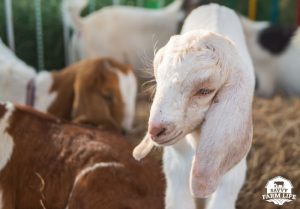
Savanna goats were developed in South Africa to create a productive meat goat that is both heat and drought-tolerant. Savanna goats are large-framed, have a similar body composition to Boers, and have all-white hair. White hair or fur (or feathers, when considering poultry) are desirable in the meat market because it makes for a more visually appealing carcass. Though Savannas have the desirable white hair, they have the dark skin and melanin required to protect them against the sun’s UV rays.
Savanna goats are well-muscled and mature more quickly than the average goat breed. They also have exceptional fertility rates with rugged kids, though they tend to be strictly seasonal breeders.
#7 Meat Goat Breed: Texmaster Goat
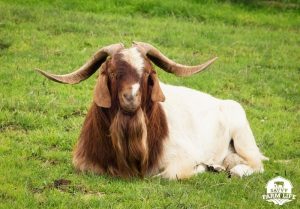
The Texmaster is a relatively new breed developed in the 1990s in Texas. The goal in developing the Texmaster was to create a goat with both the high meat-to-bone ratio seen in the Myotonic and the fast growth rate of the Boer. While many breeders sell 50/50 Myotonic/Boer crosses and advertise them as “Texmasters,” true Texmasters can all be traced back to Onion Creek in Texas and have been bred true over generations.
Texmasters are highly tolerant of parasites and make excellent mothers. Their kids are hardy and do better in colder climates than many other breeds. Texmasters are highly-muscled, and some may “faint” like their Myotonic ancestors. The more substantial the fainting gene, the higher the muscle percentage and the slower the growth. While this leads to a trade-off in meat-to-bone ratio and growth rate, most Texmaster goats will have been bred to bring out the best of both traits.
#8 Meat Goat Breed: Pygmy Goat
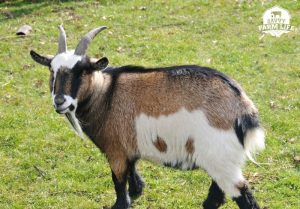
Pygmy goats are one of the smallest breeds of goat available and were developed in West Africa as goats of a manageable size that can be used for both meat and milk. Unlike the Nigerian Dwarf, which was also developed in West Africa as productive rural livestock, the Pygmy is prized for its meat production over its dairy production. It is a small, stocky breed tolerant to many diseases and parasites, does well in hot climates, and breeds prolifically out-of-season.
Pygmy goats are much smaller than other commercial and traditional meat breeds. They reach a mature height of only 16-23 inches and weigh 55-85 pounds when fully grown. The small size and docile nature of the Pygmy make them an excellent choice for family homesteads and have also gained their popularity as pets. To learn more about Pygmy goats, visit my article How Much Do Pygmy Goats Cost? Buying Guide.
Goat Meat: Healthy, Eco-Friendly, And Easier To Raise
Goat meat is a healthier red meat option due to its low cholesterol and saturated fat content and high protein and iron values. Goats are also friendlier to the environment than cows and easier to raise. For these reasons, goat meat has gained popularity in the United States over the last several decades and is expected to continue on this trend in coming years. If you are considering raising goats for meat on your homestead – or commercially – you can’t go wrong with the breeds listed here.
Do you want to raise goats but don’t have cleared land or pasture space? Check out my article Can Goats Live in the Woods?
